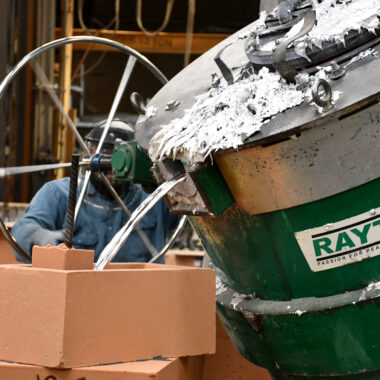Enhancing Performance: Let Loose the Power of Aluminum Casting for Superior Products
Enhancing Performance: Let Loose the Power of Aluminum Casting for Superior Products
Blog Article
Unveiling the Various Sorts Of Aluminum Spreading Processes for Precision Results
Light weight aluminum casting processes play an essential function in the manufacturing industry, offering a wide range of techniques to attain precision results in the manufacturing of elaborate parts and elements. From die casting to sand spreading, investment casting, permanent mold casting, and centrifugal casting, each technique brings its own set of advantages and details to the table. Recognizing the subtleties of these procedures is important for makers seeking to maximize their manufacturing procedures and make sure the best results. By exploring the unique qualities of each casting approach, a deeper insight into the world of light weight aluminum casting can be acquired, shedding light on the optimum method for attaining accuracy lead to different applications.
Pass Away Casting Process
This procedure entails forcing liquified steel into a steel mold dental caries under high stress. The mold and mildew, likewise understood as a die, is typically made in 2 parts: the cover die fifty percent and the ejector die fifty percent.
One of the crucial benefits of die spreading is its ability to generate parts with thin walls, detailed information, and smooth surface areas. This makes it a recommended selection for sectors such as automotive, aerospace, and electronics where complicated metal components are called for. Additionally, die casting deals outstanding dimensional precision, enabling minimal post-processing needs.
Moreover, pass away spreading can be categorized right into hot chamber and cool chamber pass away casting procedures. In warm chamber die spreading, the liquified metal is included in a furnace while in chilly chamber pass away spreading, the liquified steel is ladled right into the chilly chamber for each shot. aluminum casting. Each method has its very own set of advantages and is picked based upon the particular requirements of the project
Sand Casting Approach
Using a centuries-old strategy, the sand casting technique is a commonly made use of procedure in the manufacturing market for developing metal elements. This technique includes creating a mold and mildew made of compressed sand into which molten steel is put, permitting it to solidify and take the form of the mold and mildew dental caries. Sand spreading is valued for its adaptability, as it can generate a broad array of complicated sizes and shapes, making it appropriate for different sectors such as vehicle, aerospace, and art shops.
Among the key advantages of sand casting is its cost-effectiveness, especially for low to tool quantity production runs. In addition, the sand mold and mildews can be recycled multiple times, minimizing product waste and total manufacturing costs. In spite of its lengthy history, modern-day innovations in sand spreading methods, such as the use of computer system simulations for mold design and 3D printing for producing complex patterns, have actually better improved the accuracy and effectiveness of the procedure. On the Learn More whole, the sand spreading method remains a preferred choice for manufacturers looking for a trustworthy and economical method to generate premium steel components.
Investment Casting Strategy

This method is favored for its capacity to produce complicated forms with high precision and fine surface coatings. Industries such as aerospace, automobile, and fashion jewelry depend on investment spreading for elements that require intricate details and tight tolerances. The procedure enables cost-effective manufacturing of small to medium-sized parts in numerous products, making it a flexible choice for manufacturers seeking precision outcomes.
Irreversible Mold And Mildew Spreading
With a focus on developing steel components through a recyclable mold and mildew, Long-term Mold Spreading offers an alternative method to the elaborate precision of investment casting. aluminum casting. This technique, also called gravity pass away spreading, includes making use of a long-term metal mold generally made from steel or cast iron. The mold and mildew is preheated before the liquified metal is poured right into it, enabling faster solidification compared to sand casting
Permanent Mold Casting enables the manufacturing of premium, dimensionally exact parts with a fine surface area finish. By making use of a multiple-use mold and mildew, suppliers can achieve price savings in time as the mold and mildew can be utilized multiple times without considerable deterioration. This process is ideal for high-volume manufacturing runs where consistency and performance are critical.
Among the essential advantages of Long-term Mold Spreading is its capacity to produce intricate shapes and detailed designs easily. aluminum casting. The method is widely used in the vehicle, aerospace, and electronic devices markets for making elements such as engine parts, heat sinks, and structural aspects

Centrifugal Spreading Approach
The Centrifugal Casting Approach is an approach that includes turning a mold and mildew at broadband while putting molten metal into it. This procedure utilizes centrifugal pressure to disperse the molten metal check evenly along the walls of the mold, leading to a premium, dense spreading. The centrifugal force pushes contaminations and gases towards the inner size of the spreading, resulting in a cleaner final item with improved mechanical residential or commercial properties.
Among the vital benefits of centrifugal spreading is the capacity to generate cylindrical or disk-shaped components with a fine-grained structure that boosts the mechanical homes of the spreading. This technique is specifically ideal for producing balanced components such as rings, Bonuses pipelines, and tubes. In addition, centrifugal casting provides the benefit of being an economical process with reasonably low tooling expenses compared to other casting methods.
Verdict
In verdict, recognizing the numerous types of light weight aluminum spreading procedures is essential for achieving exact results in manufacturing. Each approach has its own advantages and restrictions, making it essential to select the most ideal process based on the particular requirements of the job. Whether it is pass away spreading, sand casting, investment spreading, long-term mold and mildew spreading, or centrifugal casting, selecting the best strategy can result in cost-effective and top quality manufacturing end results.
From die spreading to sand spreading, investment casting, long-term mold casting, and centrifugal casting, each approach brings its very own collection of benefits and intricacies to the table. By checking out the unique attributes of each spreading approach, a much deeper insight right into the world of light weight aluminum casting can be acquired, shedding light on the ideal strategy for achieving precision results in different applications.
In warm chamber die casting, the molten metal is contained in a heater while in chilly chamber die spreading, the liquified steel is ladled into the cool chamber for each shot.With an emphasis on developing metal parts via a recyclable mold and mildew, Long-term Mold and mildew Spreading offers a different method to the elaborate accuracy of investment spreading. Whether it is pass away casting, sand casting, investment casting, long-term mold spreading, or centrifugal casting, selecting the ideal technique can lead to cost-effective and premium manufacturing end results.
Report this page